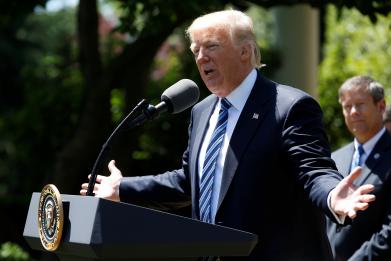President Donald Trump has threatened to force a shutdown of the federal government this fall if Congress doesn’t fund his proposed border wall with Mexico—and it is an idea that is almost universally opposed by congressional Democrats as well as by a key bloc of Republicans. The chances of a shutdown occurring, though, may be smaller than they seem.
The president and Congress have until the end of September to pass a new budget—or some kind of stopgap funding measure—in order to keep the federal government up and running. During a campaign rally in Phoenix on Tuesday night, the president said he would allow a shutdown of the government unless he was sent a budget that included funding for a border wall. In May, despite somewhat similar bluster, the administration allowed funding for this year’s budget to go forward without monies for a wall.
Still, there’s pretty good reason to believe that Congress and the White House can avoid the kind of federal shutdown that the country last endured in 2013, when it went 16 days without a budget in place. While many government functions continued, such as air traffic control and the military, much of the federal workforce was sent home, slowing the economy, stymying markets and frustrating millions of Americans. National Parks were closed, for instance, causing huge headaches for tourists who had planned getaways as well as for local economies dependent on them.
Trump’s definition of a border wall has been opaque enough and fungible enough that there is some room for compromise. Recall that originally Trump said Mexico would pay for the wall, which would have seemed to obviate the need for any U.S. taxpayer dollars. Later, Trump amended that to saying the American people would pay for the wall but Mexico would reimburse Washingtonlater—something that Mexican officials, including President Enrique Peña Nieto, have vowed will never happen and that few lawmakers in Washington expect. If Trump can play fast and loose with the definition of who pays, then there’s some cause for hope that Congress and the president can agree on what gets financed.
Of course, predicting what Trump is going to do can seem like a fool’s errand. The wall was a signature issue of his presidential campaign, and his willingness to make it the subject of an explicit threat to Congress seemed well calculated. The question is whether come October, if markets are truly jittery, the president and Congress would be able to find a deal.
The last shutdown was driven by Senator Ted Cruz over the Affordable Care Act. It went on for more than two weeks, with 800,000 federal employees staying home and a million more unsure each day of whether they would have work. After all that self-inflicted pain on the economy, Republican conservatives relented and a measure passed that continued funding for the ACA.
 Lebanese Ministry of Information
Lebanese Ministry of Information



